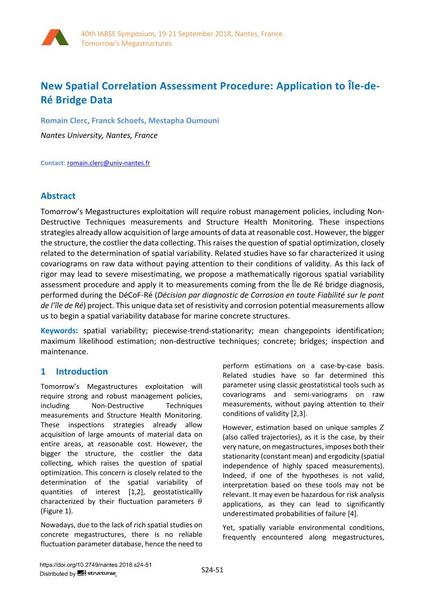New Spatial Correlation Assessment Procedure: Application to Île-de- Ré Bridge Data

|
|
|||||||||||
Bibliographic Details
| Author(s): |
Romain Clerc
(Nantes University, Nantes, France)
Franck Schoefs (Nantes University, Nantes, France) Mestapha Oumouni (Nantes University, Nantes, France) |
||||
|---|---|---|---|---|---|
| Medium: | conference paper | ||||
| Language(s): | English | ||||
| Conference: | IABSE Symposium: Tomorrow’s Megastructures, Nantes, France, 19-21 September 2018 | ||||
| Published in: | IABSE Symposium Nantes 2018 | ||||
|
|||||
| Page(s): | S24-51 | ||||
| Total no. of pages: | 8 | ||||
| DOI: | 10.2749/nantes.2018.s24-51 | ||||
| Abstract: |
Tomorrow’s Megastructures exploitation will require robust management policies, including Non- Destructive Techniques measurements and Structure Health Monitoring. These inspections strategies already allow acquisition of large amounts of data at reasonable cost. However, the bigger the structure, the costlier the data collecting. This raises the question of spatial optimization, closely related to the determination of spatial variability. Related studies have so far characterized it using covariograms on raw data without paying attention to their conditions of validity. As this lack of rigor may lead to severe misestimating, we propose a mathematically rigorous spatial variability assessment procedure and apply it to measurements coming from the Île de Ré bridge diagnosis, performed during the DéCoF-Ré (Décision par diagnostic de Corrosion en toute Fiabilité sur le pont de l’île de Ré) project. This unique data set of resistivity and corrosion potential measurements allow us to begin a spatial variability database for marine concrete structures. |
||||
| Keywords: |
concrete bridges inspection and maintenance non-destructive techniques spatial variability piecewise-trend-stationarity mean changepoints identification maximum likelihood estimation
|
||||
